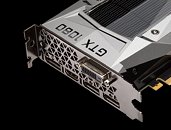Monday, June 27th 2016

GeForce GTX "Pascal" Faces High DVI Pixel Clock Booting Problems
The second design flaw to hit the GeForce GTX 1080 and GTX 1070 after the fan revving bug, isn't confined to the reference "Founders Edition" cards, but affects all GTX 1080 and GTX 1070 cards. Users of monitors with dual-link DVI connectors are noticing problems in booting to Windows with pixel clocks set higher than 330 MHz. You can boot to windows at default pixel clocks, and when booted, set the refresh-rates (and conversely pixel clocks) higher than 330 MHz, and the display works fine, it's just that you can't boot with those settings, and will have to revert to default settings each time you shut down or restart your machine.
A user of a custom-design GTX 1070 notes that if the refresh rate of their 1440p monitor is set higher than 81 Hz (the highest refresh rate you can achieve with pixel clock staying under 330 MHz) and the resolution at 2560 x 1440, the machine doesn't correctly boot into Windows. The splash screen is replaced with flash color screens, and nothing beyond. The system BIOS screen appears correctly (because it runs at low resolutions). The problem is also said to be observed on a custom-design GTX 1080, and has been replicated by other users on the GeForce Forums.
Source:
Reddit
A user of a custom-design GTX 1070 notes that if the refresh rate of their 1440p monitor is set higher than 81 Hz (the highest refresh rate you can achieve with pixel clock staying under 330 MHz) and the resolution at 2560 x 1440, the machine doesn't correctly boot into Windows. The splash screen is replaced with flash color screens, and nothing beyond. The system BIOS screen appears correctly (because it runs at low resolutions). The problem is also said to be observed on a custom-design GTX 1080, and has been replicated by other users on the GeForce Forums.

147 Comments on GeForce GTX "Pascal" Faces High DVI Pixel Clock Booting Problems
The issue is the pixel clock. Pixel clock patchers exist, to exceed the limitations in the graphics drivers.
In fact I am confident that there's more 120hz 1440p monitor owners running DVI then there are running Display Port. Mass marketed 1440p 120hz+ isn't even a thing and it's only the past several years. that consumers have taken to 1440p (at 60hz let alone 120/144hz) over 1080p - of which is still the industry standard.
Also, the issue is not present on any other connection other than DVI.
That's like saying a car motor was designed and 'oops look I guess you can tune it for more horsepower by turning up the turbo boost pressure.. oh dear look what we've done'Maybe, but that doesn't change the fact that a lot of people have DVI-D monitors running high frequencies.
Do you complain to Intel or AMD/nVidia that your overclock on your CPU or GPU is making your computer fail to boot?
It does not make sense.
So yes, it looks to be a mistake - and based on what I've informed you of, one that affects a lot of users.
2) The 8320E, which overclocks to 5 GHz with the right board, is $90 at Microcenter most of the time, with $40 off a board, too. People who buy the more expensive 8 core FX processors are paying a premium for not doing their homework — something extremely common in the world of consumerism and hardly enough to make AMD somehow a bad company. Corporations are out there to sell you less than what you're paying for. That's how profit-seeking works. You don't even need a Microcenter to get a low price on an FX, although it is true that the extra cost of cooling and a robust power supply can make it less of a value option.
If I were in the market for a budget gaming system I'd get a 5675C Broadwell and overclock it some. The CPU is more expensive than an FX but its gaming efficiency is quite a bit higher. Skylake doesn't really offer anything since Intel refused to put EDRAM on even one SKU.
3) i3 CPUs don't equal or outperform an overclocked 8 core FX in some workloads. Even though the FX design is old and it's still on 32nm it has 8 integer cores. Many integer-heavy workloads that are highly threaded will be good enough on an FX even today. If your workload is heavily floating point then look elsewhere.
Intel does not support overclocking. If your CPU does not run outside of it's specified voltage and clock speed, you can't really be angry at them about it, can you?
Its clear your statement was bullshit and now you're playing mental gymnastics to prevent from admitting your statement was stupid.
It's bad enough to post with an abusive tone without resorting to fabrication.
Anywho, what I was trying to say was:While the number may be small, the whole Korean monitor shebang was a thing because of those monitors reaching over 120Hz on dual link DVI. Infact I have a crossover 27" 1440p monitor that I run daily at 120hz for gaming over a single dual link DVI cable.
Currently this issue sucks as every time I boot, my screen has 4 mirrored screens in each corner instead of one display. I can edit and post a screenshot later if interested but imagine that the GPU just uses the 4 quadrants as separate displays that are in mirror mode.
It's quite strange and I've never had this issue before, ever reboot it happens now, I have to launch NVidia control panel and refresh my screen settings to get it back to a single display so I can use it.
I really hope this is fixed soon.
All is well and back to 120hz